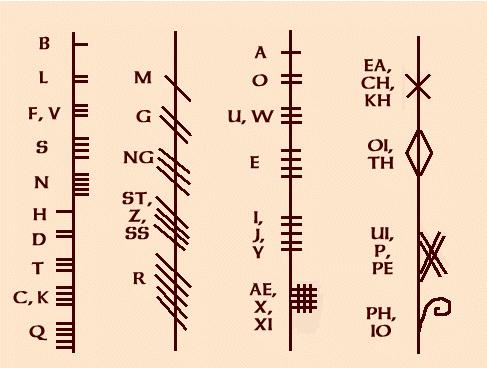|
Ogham
THE OGHAM The Celtic alphabet is known as Ogham (pronounced "Oh-m" or "Oh-wam") and
was created by the Celtic god of literature and eloquence, Ogma. He was known as "honey mouthed" and "eloquent" and has been
linked with the Gaulish God Ogmios. In the Book of Ballymote, the invention of Ogham was achieved when "Ogma Sun-Face raised
four pillars of equal length", and it was upon these pillars that the characters of the letters were etched. The primary manuscript
sources for information on Ogham are The Scholars Primer (Auraicept Na nEces), Values of the Forfeda (De Duilib Feda na Forfid),
and the Book of Ogham (Leber Ogam). There are 369 verified examples of Ogham writing surviving today. These
exist in the form of gallán (standing stones) concentrated in Ireland but scattered across Scotland, the Isle of Man, South
Wales, Devonshire, and as far afield as Silchester in Italy. Similar markings, dating to 500 BC, have been found on standing
stones in Spain and Portugal. The discovery of similar carvings in the state of West Virginia in the United States, has caused
some speculation that the Celts may have come to the New World as early as 100 BC. There are numerous accounts in the ancient literature which suggests that
Ogham was a type of writing and signalling that was used only by the bards , druids and warriors. The druid could use the
ridge of his nose or arm and stroke across it in different ways with his fingers to denote the different symbols. One Ogham
symbol could mean many different whole words for example 'B' meant Birch, Beginning, White, Pheasant(Besan), Birth, Fertility
as well as others. The type of object it was carved into had symbolism also. Such as if it was carved into Alder, it was a
"bad" omen, thus it was used for funerary measuring and was much feared. The most famous Ogham system today is the Tree Ogham, which was split up
into: Eight Chieftain trees, eight peasant trees and eight shrub trees. The letters are constructed using a combination of
lines placed adjacent to or crossing a midline. Vowels were sometimes described as a combination of dots. The midline was,
most often, the edge of the object on which the inscription was carved, this is called a 'Druim' which means ridge or spine.
An alphabet of twenty-five characters used for stone and wood inscriptions in Celtic Britain and Ireland. An alphabet of twenty
characters reportedly used for divination and hand-signing in paganism. Each of the Ogham's twenty letters bears the name
of a tree-- A: 'Ailim' (Elm), B: 'Bithe' (Birch), C: 'Coll' (Hazel), for example. The Ogham alphabet is read up and down on megaliths and boundary markers
or horizontally left to right in manuscripts.
|

